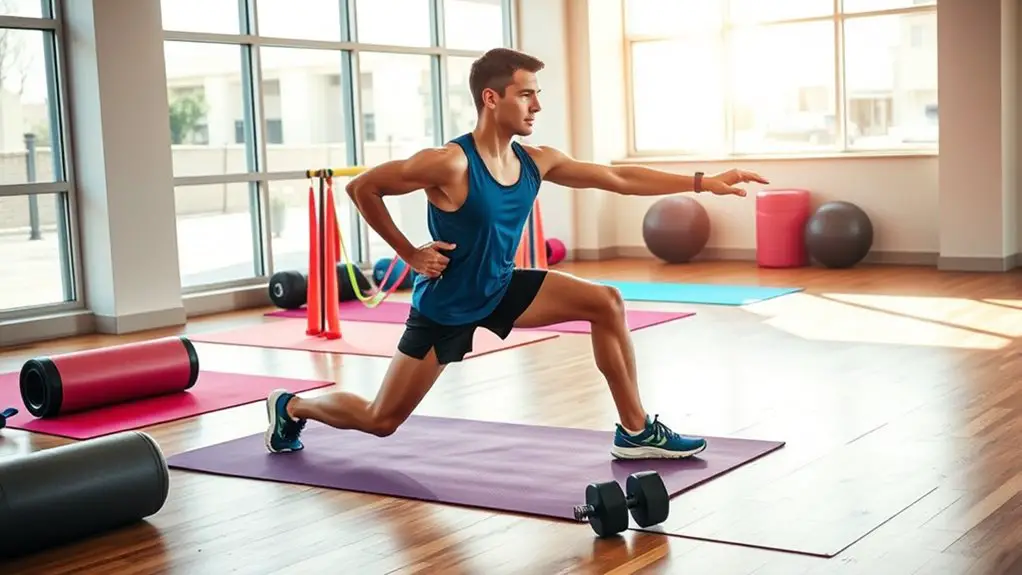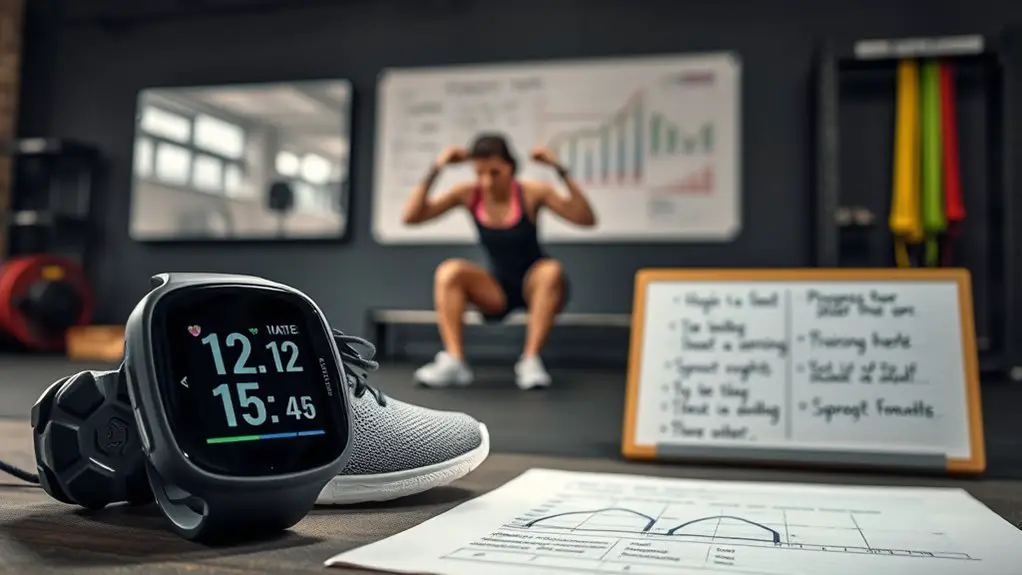How to Train for a Marathon Using Gym Workouts

To train for a marathon using gym workouts, focus on strength training, endurance, and flexibility. Build key muscle groups like your core, legs, and upper body with exercises like squats, lunges, planks, and push-ups. Incorporate endurance circuits and cross-training activities like cycling and swimming to enhance cardiovascular fitness while reducing injury risk. Prioritize flexibility with dynamic stretching before workouts. By incorporating these elements, you’ll be well on your way to achieving your marathon goals—and there’s more to discover!
The Importance of Strength Training in Marathon Preparation

While you might think running alone is enough to prepare for a marathon, incorporating strength training into your routine is crucial for achieving peak performance. Strength training benefits you by enhancing muscle endurance, improving running economy, and boosting overall power. When you build stronger muscles, you’re better equipped to handle the physical demands of long-distance running.
Moreover, strength training serves as a critical component of injury prevention strategies. By fortifying key muscle groups, you reduce the risk of common running injuries like shin splints and tendonitis. A well-rounded program that includes exercises targeting your core, hips, and legs can greatly improve your stability and balance, allowing for a more efficient stride.
Key Muscle Groups to Focus on for Runners
To maximize your marathon performance, you need to focus on key muscle groups that support your running mechanics. By developing core stability and strength, enhancing leg power, and building upper body endurance, you’ll boost your overall efficiency and reduce the risk of injury. Let’s explore how targeting these areas can elevate your training and prepare you for race day.
Core Stability and Strength
Core stability and strength are essential for runners, as they provide the foundation for efficient movement and injury prevention. To achieve this, focus on exercises that promote core engagement, like planks and Russian twists. These not only strengthen your abdominal muscles but also enhance your overall body control. Incorporating balance training, such as single-leg stands and stability ball workouts, will improve your coordination and help you maintain proper running form. Remember, a strong core supports your pelvis and spine, reducing the risk of injuries during long runs. Prioritize these exercises in your gym routine, and you’ll notice improved endurance and performance on race day. Stay committed, and your body will thank you!
Leg Power Development
A strong core sets the stage for developing leg power, which is essential for runners aiming to improve speed and overall performance. To target key muscle groups, focus on squat variations, like front squats and jump squats. These exercises not only build strength but also enhance explosive power, vital for sprinting and hill climbs. Incorporating plyometric exercises, such as box jumps and bounding, will further develop your fast-twitch muscle fibers, promoting agility and speed. Aim to integrate these workouts into your routine two to three times a week, ensuring sufficient recovery between sessions. By prioritizing leg power development, you’ll enhance your running efficiency, helping you achieve your marathon goals with confidence and strength.
Upper Body Endurance
While many runners focus primarily on their legs, neglecting upper body endurance can hinder overall performance. Strong upper body strength supports your running form, helping you maintain proper posture and reducing fatigue. When your arms can efficiently pump during long runs, they contribute to your pace and stamina.
To improve upper body endurance, incorporate targeted endurance workouts into your routine. Exercises like push-ups, dumbbell presses, and rows can enhance muscular endurance, while planks and medicine ball twists increase core stability. Aim for higher repetitions with lower weights to build endurance without bulk. Remember, a balanced approach to training will help you not only finish your marathon but do so with power and confidence. Embrace upper body workouts, and watch your performance soar!
Effective Gym Workouts for Building Endurance
Building endurance is essential for marathon training, and effective gym workouts can be a game-changer. To boost your stamina, focus on endurance circuits that combine cardio and strength exercises. Start with a warm-up, then alternate between exercises like squats, lunges, and push-ups, all while keeping your heart rate elevated. Aim for 30-60 seconds per exercise, followed by a short rest, and repeat the circuit multiple times.
Incorporate interval training into your routine to enhance your speed and endurance. This could involve sprinting on a treadmill for 30 seconds, followed by one minute of walking or jogging. Repeat this cycle for 15-20 minutes. Additionally, consider integrating jump rope exercises into your regimen, as they can serve both aerobic and anaerobic benefits for your overall fitness.
Incorporating Flexibility and Mobility Exercises

To maximize your marathon training, you can’t overlook the importance of flexibility and mobility exercises. Incorporating effective mobility drills and targeted stretching techniques will enhance your range of motion, prevent injuries, and improve your performance. Let’s explore how these elements can elevate your training regimen and prepare you for race day.
Importance of Flexibility Training
Incorporating flexibility training into your marathon preparation is essential, as it can greatly enhance your overall performance and reduce the risk of injury. By integrating dynamic stretching and flexibility routines into your workouts, you’ll improve your range of motion and muscle elasticity. Here are four key benefits of flexibility training:
- Injury Prevention: Enhanced flexibility reduces strain on muscles and joints.
- Improved Performance: Greater range of motion leads to more efficient running mechanics.
- Faster Recovery: Stretching helps alleviate soreness and promotes quicker healing.
- Balanced Musculature: Flexibility training corrects imbalances, fostering overall strength.
Make flexibility training a priority in your plan, and you’ll set yourself up for a successful marathon journey!
Effective Mobility Drills
After establishing a solid foundation with flexibility training, incorporating effective mobility drills can take your marathon preparation to the next level. Focus on dynamic stretches that enhance your range of motion and prepare your muscles for the demands of running. Exercises like leg swings, arm circles, and walking lunges not only promote joint mobility but also activate the muscle groups you’ll rely on during long runs.
Incorporate these drills into your warm-up routine, dedicating 10-15 minutes before workouts. This will increase blood flow, reduce the risk of injury, and improve your overall performance. Remember, effective mobility is essential for maintaining proper form and efficiency as you tackle those miles. Embrace these drills, and watch your marathon training soar!
Stretching Techniques for Runners
A well-rounded stretching routine is essential for runners looking to enhance their performance and prevent injuries. Incorporating both dynamic and static stretching into your regimen can improve your flexibility and mobility. Here are four key techniques to include:
- Dynamic Stretching: Perform leg swings and walking lunges before your runs to warm up your muscles.
- Static Stretching: After your runs, focus on holding stretches like hamstring and quad stretches for 20-30 seconds.
- Foam Rolling: Use a foam roller to release tight muscles, especially in your calves and IT bands.
- Hip Openers: Include stretches like the pigeon pose to maintain hip flexibility, vital for a smooth running gait.
Embrace these techniques, and you’ll notice a significant difference in your running experience!
Cross-Training Options to Enhance Cardiovascular Fitness

Cross-training offers a powerful way to boost your cardiovascular fitness while reducing the risk of injury during marathon training. Incorporating activities like cycling and swimming can enhance your endurance without the repetitive strain of running.
Consider adding cycling intervals to your routine. Short bursts of high-intensity cycling followed by recovery periods can greatly elevate your heart rate and improve your stamina. Aim for at least two sessions a week, focusing on varying your resistance and speed.
Swimming drills are another excellent option. They provide a full-body workout while being gentle on your joints. Try incorporating interval sprints or longer, steady swims to build aerobic capacity.
Sample Weekly Gym Workout Plan for Marathon Training
While you might think that running alone is sufficient for marathon training, integrating a structured gym workout plan can greatly enhance your performance and resilience. A well-rounded gym workout schedule focusing on strength training basics will help you build the necessary muscle to support your running.
Integrating a structured gym workout plan can significantly enhance your marathon performance and resilience.
Here’s a sample weekly gym workout plan:
- Monday: Lower body strength training – squats, lunges, leg presses.
- Wednesday: Upper body strength training – push-ups, rows, shoulder presses.
- Friday: Core workout – planks, Russian twists, medicine ball exercises.
- Saturday: Cross-training – cycling or swimming to improve cardiovascular fitness without the impact.
Incorporating these workouts with your running routine can greatly boost your endurance and reduce the risk of injury. Stay consistent, and remember, every workout counts towards your marathon goal!
Tips for Avoiding Injury Through Proper Training

Incorporating gym workouts into your marathon training not only builds strength but also plays a significant role in injury prevention. To maximize your training while minimizing the risk of injury, prioritize balance in your workout routine. Include strength training, flexibility exercises, and cross-training to support your running.
Listen to your body—if you’re feeling fatigued, don’t hesitate to take rest days. These days are essential for recovery, allowing your muscles to repair and grow stronger.
Focus on proper form during all exercises; poor technique can lead to injuries that sideline your progress. Gradually increase your workout intensity, avoiding sudden changes in volume or frequency.
Finally, incorporate dynamic stretching before workouts and static stretching afterward to improve flexibility and prevent strains. Regular exercise can also help prevent chronic diseases, ensuring you stay healthy and ready to race. By following these tips, you’ll create a solid foundation for your marathon training, ensuring you stay healthy and ready to race.
Nutrition and Hydration: Supporting Your Gym Workouts
To fuel your gym workouts effectively, it’s important to prioritize nutrition and hydration as key components of your marathon training plan. Proper nutrition strategies and hydration tips will enhance your performance and recovery, enabling you to train harder and smarter.
Prioritizing nutrition and hydration is essential for optimizing your marathon training and enhancing your overall performance.
Here’s what you should focus on:
- Balanced Diet: Incorporate a mix of carbohydrates, proteins, and healthy fats to support energy levels and muscle recovery.
- Pre-Workout Nutrition: Eat a light meal or snack rich in carbs about 30-60 minutes before your workout to boost energy.
- Hydration: Drink water throughout the day, aiming for at least half your body weight in ounces. Consider electrolyte drinks during long sessions.
- Post-Workout Recovery: Consume a protein-rich meal or shake within 30 minutes of finishing your workout to help rebuild muscles.
Monitoring Progress and Adjusting Your Training Plan

Tracking your progress is an essential part of marathon training that can considerably enhance your performance. By regularly reviewing your workouts, you’ll identify strengths and weaknesses, allowing you to make informed plan adjustments. Start with a reliable method like a training journal or an app to log your gym workouts, running distances, and times.
Every few weeks, review your progress tracking data. Are you improving your endurance? Is your strength training translating to better running performance? If you notice stagnation or fatigue, it may be time to tweak your plan.
Incorporate more cross-training or adjust your workout intensity to prevent burnout. Remember, flexibility is key. Your body might need more recovery or a different focus as you advance. Stay committed, and don’t hesitate to modify your approach as necessary. Consistent evaluation will keep you on track to meet your marathon goals.
Frequently Asked Questions
How Long Should I Train Before My First Marathon?
When you’re preparing for your first marathon, a solid training timeline is essential. Generally, you should aim for a training period of 16 to 20 weeks. This allows your body to gradually adapt, build endurance, and prevent injuries. Start with shorter runs and progressively increase your mileage. Incorporate rest days and cross-training to enhance your overall fitness. Stay consistent, listen to your body, and you’ll be ready to tackle that marathon with confidence!
Can I Substitute Gym Workouts for Outdoor Running?
Absolutely, you can substitute gym workouts for outdoor running, but balance is key. Incorporate treadmill workouts to simulate outdoor conditions and improve your endurance. Combine this with strength training to build the muscles needed for running, enhancing your overall performance. While gym workouts are effective, try to include some outdoor runs as race day approaches for acclimatization. Stay committed, listen to your body, and you’ll be well-prepared for that marathon!
What Should I Wear to the Gym While Training?
When you hit the gym, think of it as your personal arena, where comfort factors play a crucial role in your performance. You’ll want to wear gym attire that allows for flexibility and breathability. Opt for moisture-wicking fabrics to keep you dry, paired with supportive footwear that fits well. Remember, the right gear not only enhances your workout but also boosts your confidence—so choose wisely and get ready to conquer your goals!
How Do I Stay Motivated Throughout My Training?
Staying motivated throughout your training can be challenging, but goal setting is key. Break your main goal into smaller, achievable milestones to keep your spirits high. Consider finding accountability partners who share similar ambitions; they’ll help keep you on track and provide support when motivation wanes. Regularly track your progress and celebrate small wins, reinforcing your commitment. With these strategies, you’ll maintain your drive and enjoy the journey toward your ultimate goal.
Is It Necessary to Run Outside During Training?
Is it necessary to run outside during your training? While you can rely on treadmill alternatives, running outdoors offers unique benefits. The varied terrain and fresh air can enhance your stamina and mental resilience. Plus, outdoor runs help you adapt to different weather conditions, essential for race day. Incorporating both gym workouts and outdoor runs into your regimen will keep things balanced and engaging, ultimately boosting your performance and motivation.





